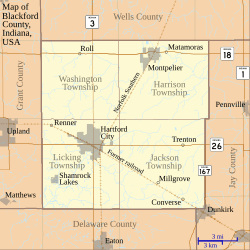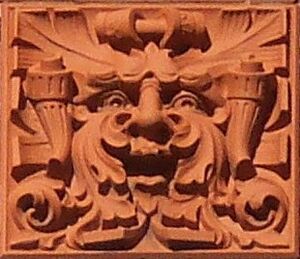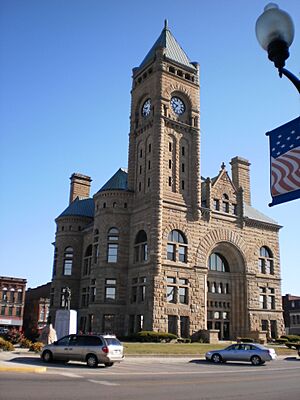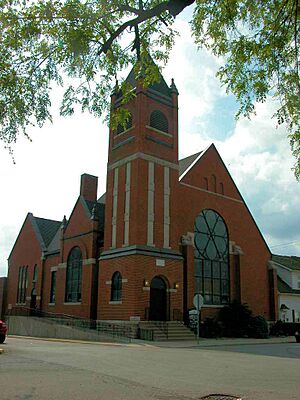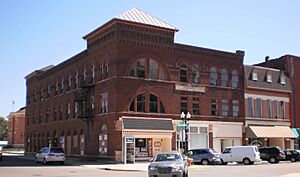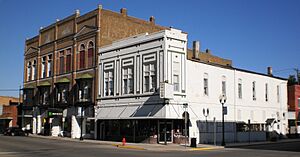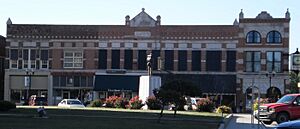Hartford City Courthouse Square Historic District facts for kids
Quick facts for kids |
|
|
Hartford City Courthouse Square Historic District
|
|
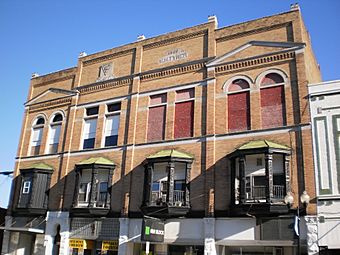
One of the buildings on Main Street in the district
|
|
| Location | Roughly bounded by Franklin, Walnut, Water and Monroe Sts., Hartford City, Indiana |
|---|---|
| Area | 19 acres (7.7 ha) |
| Architect | Arthur LaBelle; Burt French; P.J. Loney; others |
| Architectural style | Italianate, Romanesque Revival, Renaissance Revival, Queen Anne, Art Deco |
| NRHP reference No. | 06000522 |
| Added to NRHP | June 21, 2006 |
The Hartford City Courthouse Square Historic District is a special area in Hartford City, Indiana. Hartford City is a town of about 7,000 people. It is the main city, or county seat, of Blackford County. This means the county's main courthouse is located here.
The National Park Service added this district to the National Register of Historic Places on June 21, 2006. This means the buildings and objects in the district are important to save. They are special because of their past and their amazing designs. The district has over 60 important features. These include more than 40 buildings that add to its history. It also has a statue from World War I that is important.
This district became very important when natural gas was found nearby. This discovery led to a huge economic boom in the area. It was called the Indiana Gas Boom. This boom started in the late 1880s and lasted about 15 years. It completely changed the economy and look of the region. Most buildings in the Hartford City Courthouse Square Historic District were built during this exciting time. They show off many different architectural styles. Many buildings still look like they did when they were first built.
Contents
A Look Back: History of Hartford City
Hartford City started small in the late 1830s. It was just a few log cabins near a creek. The town was first called Hartford. But its name changed to "Hartford City" because another town in Indiana was already named Hartford. Hartford City quickly became the county seat for Blackford County. This made it a very important place.
It took over 40 years for the town to grow to about 1,500 people. But the people who planned the town were smart. They made sure railroads would connect Hartford City to other places. This started in the 1860s. Before the gas boom, most people in the county worked in agriculture. Only a few people worked in factories.
The Indiana Gas Boom Arrives
In February 1887, the Hartford City Gas and Oil Company was created. Just one month later, in March, they found natural gas! Some of the people who started this company have buildings named after them in the district today. Their names are Campbell, Smith, Dowell, and Weiler. Both oil and natural gas were found in the county in 1887. This made the city grow very fast.
Hartford City was called the "future big city of Eastern Indiana." It used its railroads and lots of natural gas to attract factories. The city quickly became a boom town. Other nearby counties also found natural gas. The whole East Central Indiana region changed a lot during the Indiana Gas Boom. Many factories moved to the area.
How the Gas Boom Changed the City
The Gas Boom really changed Hartford City. Before the boom, many buildings around the courthouse were made of wood. These wooden buildings often caught fire. The district had at least three big fires between 1871 and 1881. During the Gas Boom, old wooden buildings were torn down. New, strong brick buildings took their place.
The old courthouse was replaced with a beautiful stone and brick building. Later, an interurban train line ran right by the courthouse square. This made it easy to get to the shops and businesses. By 1900, the city's population had jumped to 5,912 people. In 1902, over 1,200 people worked in factories. This was a huge increase from before the Gas Boom.
After the Gas Boom
The natural gas and oil started to run out in the early 1900s. The Gas Boom era ended. But Hartford City was changed forever. The city's infrastructure (its basic systems like roads and buildings) was much better. Buildings in the downtown area were now made of brick and stone.
A city water system was built in 1894. Telephones became available in nearby rural areas by 1903. By 1914, almost all houses in Hartford City had electricity. Roads were paved, and the interurban line made travel easier. Some factories that needed cheap gas closed. But others stayed because they had nowhere better to go. The city now had many skilled factory workers. Some of these workers stayed. Others found new jobs in the growing car factories in nearby cities.
Architectural Styles of the District
The Hartford City Courthouse Square Historic District has many buildings with interesting styles. Three styles are very common: Commercial Italianate, Renaissance Revival, and Romanesque Revival. You can also find a few examples of the Queen Anne style.
These styles are often grouped as Victorian architecture. Buildings from the 1800s in these styles often have fancy decorations. For example, the Weiler Building has a face-like carving on its side. Since many buildings were built during the Gas Boom (1885-1905), these older styles are very common.
However, other styles are also present. The Scheidler Theatre is a great example of the Art Deco style. The Post Office is the only building in the Neoclassical style. The building at 210 East Washington Street is the only one in the Art Moderne style.
Romanesque Revival Style
The Romanesque Revival style was very popular in Hartford City. At least 7 buildings in the district use this style. This style is known for its round arches over windows and doors. Smooth surfaces, sometimes with decorative bands called belt courses, are also common.
A special type of Romanesque Revival, called Richardsonian Romanesque, was popular in America. This was around the late 1800s, when many buildings around Hartford City's courthouse were built. The courthouse and the Presbyterian Church are excellent examples of this style. They have corner towers, arched windows, deep entrances, and steep roofs. They also use different textures on their outside walls, like rough stone (rustication). Richardsonian Romanesque buildings often have rougher outside surfaces compared to the original Romanesque Revival style.
The Hotel Ingram, Kirshbaum, and Weiler buildings also use the Romanesque Revival style. They have arched windows and different textures.
District Boundaries and Important Buildings
The Hartford City Courthouse Square Historic District is in the original center of the town. It includes a big part of the city's historic shopping area. Hartford City was planned with square blocks and streets running north-south and east-west. This was common in towns created under the Northwest Ordinance. Having a courthouse surrounded by an open square was also a common design in the "Midwest".
The district includes the courthouse and the blocks around it. Franklin Street is the northern border. Water Street is part of the southern border. The west side goes almost to Walnut Street, and the east side goes past Monroe Street.
The map shows the district and its buildings. Buildings in orange are very important for their history or design. Two of these, the Blackford County Courthouse and the First Presbyterian Church, are already listed on the National Register of Historic Places. Buildings in bright green are also notable. Buildings in pale green add to the district's history. Dark gray areas are not part of the historic district.
Outstanding Properties in the District
The Historic Landmarks Foundation of Indiana has identified seven buildings in the district as "outstanding." This is their highest rating. These buildings are very important for their history, design, and how well they have been kept. All seven are important parts of the Hartford City Courthouse Square Historic District. Two of them are already listed on the National Register of Historic Places.
Blackford County Courthouse
The Blackford County Courthouse was added to the National Register of Historic Places on August 11, 1980. Like most buildings in the district, it was built during the Indiana Gas Boom. The county's first courthouse was old and unsafe. It was torn down in 1893 to make way for this new stone building.
The courthouse was built in 1894 by Christian Boseker & Son. It was designed by Arthur LaBelle and Burt L. French. The building uses the Richardsonian Romanesque style. It has two main entrances, one on the north and one on the south. Inside, the walls have marble panels, and the ceilings are covered with steel panels to prevent fire. This grand courthouse shows how rich Hartford City was during the Gas Boom. It stands as a symbol of that time. The courthouse grounds also have memorials for American wars, including the Revolutionary War, World War I, World War II, Korean War, Vietnam War, and Civil War.
First Presbyterian Church
Hartford City's First Presbyterian Church joined the National Register of Historic Places on June 13, 1986. Local architect Alec Gable designed the building. It was also built in the Richardsonian Romanesque style. This impressive church was another big project during the Indiana Gas Boom. Construction started in 1892 and finished in 1893. It is the oldest church building in Hartford City.
The church is at the corner of Franklin and High Streets. It has huge stained-glass windows made by local glass workers. The chapel has a pipe organ that was partly paid for by a gift from businessman Andrew Carnegie. The church's outside looks almost the same as it did in the 1890s, with only one small addition.
Other Outstanding Properties
- Blackford County Jail This jail was finished in 1879. It is a great example of the Italianate style. It is at 120 East Main Street. The jail is the oldest building still standing in the Courthouse District.
- Campbell Building Built in 1901, this building uses the Renaissance Revival style. The two-story building has a large gable at the top. It has a stone tablet that says "1901 Campbell." This building is at 207-211 West Washington Street. It was originally an office building. Many different professionals, like lawyers, dentists, and doctors, had offices here.
- Ervin Building The Ervin Building was built around 1890 in the Queen Anne style. It is at 201-205 West Washington Street. This corner building has three oriel windows on its front. The name "Ervin" is in stained-glass in the middle of the building. A store called Campbell & Ervin, which sold clothes, hats, and shoes, was here in the 1890s.
- Kirshbaum Building This building was constructed in 1893 in the Romanesque Revival style. It is on the corner of High and Washington Streets, at 123 West Washington Street. The city's First National Bank was an early tenant. Its name is carved in stone on the building. "1893 Kirshbaum" is also carved at the top. Raphael Kirshbaum, a German merchant, built this building. He sold goods in several Indiana cities.
- United States Post Office Hartford City's Post Office is one of the few buildings in the district not built during the Gas Boom. It was built during the Great Depression, starting in 1934 and finishing in 1935. Designed by Louis A. Simon, it is the only building in the district in the Neoclassical style. It is located at 123 South High Street.
Notable Properties
The Historic Landmarks Foundation of Indiana also listed five properties in the district as "notable." These are very important, just below the "outstanding" rating. They might even be important enough to be listed on the National Register of Historic Places after more study. All five of these buildings are important parts of the Hartford City Courthouse Square Historic District.
- 210 East Washington Street Commercial Building This building was built around 1940. It uses the Art Modern style, which came from Art Deco. This style is unique in the Courthouse District.
- Hotel Ingram This three-story building is in the Romanesque Revival style. It is on the corner of Jefferson and Main streets, at 118-122 North Jefferson Street. The name "Hotel Ingram" is written in stone on the second floor. The building was built in 1893 and opened on January 9, 1894. It had 45 guest rooms and a large dining room. It also had a saloon called the Ingram Bar. The hotel was very popular, with 1,200 guests in its first month.
- Knights of Pythias/Tyner Building Designed by A. W. Maxwell, this building was built around 1900. Its style mixes Romanesque, Classical, and Queen Anne. It is located at 204–210 West Main Street.
- Rosenbush Building This Renaissance Revival building was built around 1890. It is at 110 West Main Street. The name Rosenbush is on a stone tablet. The building has terra cotta star patterns above the windows. Tailor Aaron W. Rosenbush had his business here. The building also housed Rosenbush's Royal Theatre, where silent movies were shown with piano music.
- Scheidler Theater This "very elegant and beautifully decorated" building was first called the Hartford Theatre. It was built in 1947, after the Gas Boom. Its style is Art Deco. It is located at 122 East Washington Street.
Other Important Properties
Many other buildings, besides those listed as outstanding or notable, also contribute to the Hartford City Courthouse Square Historic District. Many of these were also built during the Gas Boom. Here are some examples:
In the Gas Boom era, the word "block" was often used for a building with many offices or stores. These "block" buildings did not take up a whole city block. But they often had several shops or offices with different businesses. For example, the "Briscoe Block" had many businesses inside. Most building names used here come from National Register forms or publications from Indiana Landmarks.
- Bank Block This two-story building was built in the Commercial Italianate style in the 1880s. In the early 1900s, Citizen's State Bank was here. A law firm and a barber also had offices in the "Bank Block." The southern part of the building still looks mostly original. It is at 100 North Jefferson Street. However, the northern part has been changed a lot and is now a separate building.
- Briscoe Building This two-story Romanesque Revival building was built in 1893. It is at 113-121 West Washington Street. It uses three colors of brick, making it look like three sections. While the new courthouse was being built in 1893-1894, Blackford County's courtroom and clerk's office were in this building. In 1899, a fire damaged the roof, but the rest of the building was saved. Businesses like Kentucky Liquors, Western Union, and a grocery store were here.
- Dowell Building This building was built in 1893 in the Italianate style. It is at 107-109 West Washington Street. Frank P. Dowell had an office here. He handled real estate, loans, and insurance. Frank's father, Jessie H. Dowell, started the Hartford City Natural Gas and Oil Company. This company drilled the city's first successful natural gas well in 1887.
- W.H. Gable Block This two-story Commercial Italianate building was built in 1891. It is at 118-122 West Main Street. Five brick columns divide it into three storefronts and a staircase. "W.H. Gable 1891" is at the top. William H. Gable made money in the California Gold Rush. He used it to start businesses like furniture and real estate. This building was built on his first real estate investment.
- Griffin Buildings Two Griffin buildings are side by side at 106 and 108 East Washington Street. The name "Griffin" is on the top of both. Both were built around 1900. The building at 106 East Washington Street is in the Romanesque Revival style.
- E. Smilack Building This building is at 203 East Washington Street. It was built around 1910 in the Craftsman style. A stone tablet above the second floor says "E. Smilack." Elbert Smilack came to the United States in 1899. He started a junk business with a small loan. He became very successful in scrap metal, furs, and coal. By 1914, he was one of the richest men in Blackford County.
- Sowers & Gough Drugstore This corner building at 200 West Main Street was built around 1910. It was remodeled in the Art Deco style around 1940. Cecil Gough moved his drugstore here. It became a popular spot in the 1930s and 1940s because it had a soda fountain and seating.
- Weiler Building This three-story building was finished in 1896. It is in the Romanesque Revival style. The name Weiler is on a stone tablet on the third story. The top part of the building has terracotta rosettes and faces of men. It is at 104 West Main Street. This building housed the Weiler Brothers department store. It was once thought to be one of the largest department stores in Indiana. The store sold many things, like hardware, furniture, and clothes. The Weiler brothers were German immigrants. The store closed in the 1920s. Sadly, parts of this building collapsed in 2014 and it was later torn down.
- World War I Memorial Hartford City's Blackford County courthouse lawn has many war memorials. The World War I memorial was the first of four large memorials placed at the corners of the lawn. It was dedicated on September 28, 1921. The sculpture is called the "Spirit of the American Doughboy."
Why This District is Important
The Hartford City Courthouse Historic District is important for two main reasons.
First, many important events happened here (Criterion A). The most important events were Hartford City becoming the county seat and the Indiana Gas Boom. This district was the historic center for business, social life, and government in Blackford County. As the county seat, the courthouse and nearby offices became the main place for county government. In the late 1880s, the Indiana Gas Boom brought huge growth and wealth. This led to many new shops, businesses, and social places being built around the courthouse.
Second, the district is important because of its collection of buildings and their architectural styles (Criterion C). Most of these buildings were built during the Indiana Gas Boom in the late 1800s or early 1900s. They still have many of their original features. Three main styles are well represented: Italianate, Renaissance Revival, and Romanesque Revival. You can also find other styles here.
See also
 In Spanish: Distrito Histórico de Hartford City Courthouse Square para niños
In Spanish: Distrito Histórico de Hartford City Courthouse Square para niños


